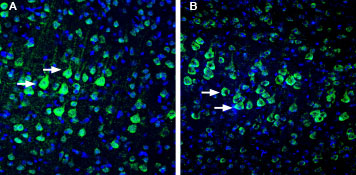Overview
- Peptide (C)KKGTEKQITPETQK, corresponding to amino acid residues 24-37 of mouse NETO1 (Accession Q8R4I7). Extracellular, N-terminus.

 Western blot analysis of rat (lanes 1 and 3) and mouse (lanes 2 and 4) brain lysates:1,2 Anti-NETO1 (extracellular) Antibody (#AGC-045), (1:200).
Western blot analysis of rat (lanes 1 and 3) and mouse (lanes 2 and 4) brain lysates:1,2 Anti-NETO1 (extracellular) Antibody (#AGC-045), (1:200).
3,4. Anti-NETO1 (extracellular) Antibody, preincubated with NETO1 (extracellular) Blocking Peptide (#BLP-GC045).
 Expression of NETO1 in rat and mouse cortex.Immunohistochemical staining of perfusion-fixed frozen rat and mouse brain sections with Anti-NETO1 (extracellular) Antibody (#AGC-045), (1:200), followed by goat-anti-rabbit-AlexaFluor-488. NETO1 staining in rat (A) and mouse (B) sections (green), is detected in cells in the deep pyramidal layer (arrows). Cell nuclei are stained with DAPI (blue).
Expression of NETO1 in rat and mouse cortex.Immunohistochemical staining of perfusion-fixed frozen rat and mouse brain sections with Anti-NETO1 (extracellular) Antibody (#AGC-045), (1:200), followed by goat-anti-rabbit-AlexaFluor-488. NETO1 staining in rat (A) and mouse (B) sections (green), is detected in cells in the deep pyramidal layer (arrows). Cell nuclei are stained with DAPI (blue).
- Fisher, J.L. et al. (2915) Neuropharmacology 99, 471.
- Cousins, S.L. et al. (2013) J. Neurochem. 126, 554.
- Fisher, J.L. and Mott, D.D. (2013) J. Physiol. 591, 4711.
NETO proteins are auxiliary subunits that play crucial roles in modulating the biophysical properties of Kainate receptors (KARs) and N-methyl-D-aspartate receptors (NMDARs). NETO proteins modulate these receptors both in vivo and in vitro. NETO1 is also responsible for the slow kinetics of postsynaptic KAR-mediated currents and regulate synaptic recruitment of Kainate receptors1.
NETO1 is a single transmembrane domain protein containing two extracellular CUB domains of about 110 amino acids, a low-density lipoprotein receptor domain, and a cytoplasmic tail of almost 167 amino acids that includes a C-terminal TRV class I PDZ binding motif2.
NETO1 and NETO2, are highly homologous, but have a different expression patterns and distinct functional effects. NETO1 subunit is expressed in high levels in the developing hippocampus and regulates axonal and presynaptic Kainate receptors at the CA3-CA1 region of the hippocampus. NETO1 deficiency resulted in impairs synaptogenesis and disrupts synchronization of the CA3-CA1 neuronal populations1,3. NETO1 is enriched in the post-synaptic density where it co-localizes with post-synaptic density-95 (PSD-95) and GluN12.
Application key:
Species reactivity key:
Anti-NETO1 (extracellular) Antibody (#AGC-045) is a highly specific antibody directed against an epitope of the mouse protein. The antibody can be used in western blot and immunohistochemistry applications. The antibody recognizes an extracellular epitope and can potentially be used for detecting the protein in living cells. It has been designed to recognize NETO1 from rat, mouse, and human samples.
